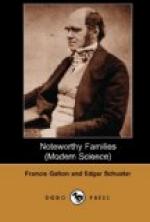It is so difficult to compare the number of those who might have succeeded with the number of those who do, that the following illustration may perhaps be useful: By adding to the 53 registration counties in England, the 12 in Wales, the 33 in Scotland and the 32 in Ireland, an aggregate of 130 is obtained. The English counties, and the others in a lesser degree, have to be ransacked in order to supply the fifteen annually-elected Fellows; so it requires more than eight of these counties to yield an annual supply of a single Fellow to the Royal Society.
It is therefore contended that the Fellows of the Royal Society have sufficient status to be reckoned “noteworthy,” and, such being the case, they are a very convenient body for inquiries like these. They are trained to, and have sympathy with, scientific investigations; biographical notices are published of them during their lifetime, notably in the convenient compendium “Who’s Who,” to which there will be frequent occasion to refer; and they are more or less known to one another, either directly or through friends, making it comparatively easy to satisfy the occasional doubts which may arise from their communications. It was easier and statistically safer to limit the inquiry to those Fellows who were living when the circulars were issued—that is, to those whose names and addresses appear in the “Royal Society’s Year Book” of 1904. Some of them have since died, full of honours, having done their duty to their generation; others have since been elected; so the restriction given here to the term “Modern Science” must be kept in mind.
Another and a strong motive for selecting the F.R.S. as subjects of inquiry was that so long ago as 1863-1864 I had investigated the antecedents of 180 of those who were then living, who were further distinguished by one or other of certain specified and recognised honours. My conclusions were briefly described in a Friday evening lecture, February 27, 1864, before the Royal Institution. These, together with the data on which they were founded, were published in the same year in my book “English Men of Science.” Readers who desire fuller information as to the antecedents conducive to success that are too briefly described further on should refer to the above book.
The epithet “noteworthy” is applied to achievements in all branches of effort that rank among the members of any profession or calling as equal, at least, to that which an F.R.S. holds among scientific men. This affords a convenient and sufficiently definite standard of merit. I could think of none more appropriate when addressing scientific men, and it seems to have been generally understood in the desired sense. It includes more than a half of those whose names appear in the modern editions of “Who’s Who,” which are become less discriminate than the earlier ones. “Noteworthiness” is ascribed, without exception, to all whose names appear in the “Dictionary of National Biography,”




